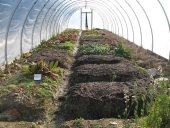
 5
5




Telling me it can't be done is my biggest motivation to making it happen.
Molly, I changed your subject title to include the wind issue in the hopes that permies with wind experience will give you input. Is that OK with you?

 8
8






How Permies works: https://permies.com/wiki/34193/permies-works-links-threads
My projects on Skye: The tree field, Growing and landracing, perennial polycultures, "Don't dream it - be it! "
 4
4




A build too cool to miss:Mike's GreenhouseA great example:Joseph's Garden
All the soil info you'll ever need:
Redhawk's excellent soil-building series





 2
2




Our inability to change everything should not stop us from changing what we can.












 6
6




How Permies works: https://permies.com/wiki/34193/permies-works-links-threads
My projects on Skye: The tree field, Growing and landracing, perennial polycultures, "Don't dream it - be it! "

 3
3




Our inability to change everything should not stop us from changing what we can.
 8
8






 6
6




"When the whole world is running towards a cliff, he who is running in the opposite direction appears to have lost his mind." C.S. Lewis
Visit https://themaineingredient.com for organic, premium dried culinary herbs that are grown, processed, and packaged in the USA.




 3
3




Telling me it can't be done is my biggest motivation to making it happen.




 2
2




Robert Ray wrote:What I have seen, and my brother uses is bailing twine crossing over the tunnels, either creating a cross or zig zagging over the film between hoops. The jelly fish effect disappears, and the tunnels shed wind admirably. I can't say that I have noticed an offensive off gassing of the greenhouse skin.
Telling me it can't be done is my biggest motivation to making it happen.




 2
2




Telling me it can't be done is my biggest motivation to making it happen.




 2
2




Matt McSpadden wrote:Hi Molly,
My high tunnel is currently in pieces on the ground, so I don't know that I have a whole lot of suggestions as to what to do... but I can suggest some things I did wrong that might help you or someone else.
First, don't leave only 1 end open if it is windy. I did this, and it caught the wind and popped a bunch of poles out and ripped the plastic off.
Keep the plastic tight. If the plastic is not tight, it causes more chafing from the wind, and therefore more chance for a hole to be made in the plastic. Loose plastic also gives more droop when the snow comes, but that wasn't what you were asking about :)
In my experience, plastic supports seem to have more springy-ness than metal, and so can take more without breaking.
Lastly, how much space do you really need? Could you build a smaller but stronger wooden greenhouse with solid plastic panels that should hold up much better and for longer than plastic?
Good luck and share what works for you.
Telling me it can't be done is my biggest motivation to making it happen.




 3
3




Nancy Reading wrote:I found the video for you. This is my tunnel in Jan 2018, you can see the antihotspot tape is already coming loose. I looked up the weather history and it says the winds on that day were about 60 mph.
I personally wouldn't think anything touching the plastic would be the best idea, since it may lead to chafing. However if it stops loose plastic flapping that would be a good idea, but not having loose plastic better. I think the flexibility of the tunnel is actually it's strength.
Telling me it can't be done is my biggest motivation to making it happen.




 4
4




Robert Ray wrote:I suggest looking at episode 23 of "Gardening with Leon" on you tube. https://www.youtube.com/watch?v=4UQ4OkYX9qc
Telling me it can't be done is my biggest motivation to making it happen.
 5
5








 2
2




Gregory Campbell wrote:When I first put up my high tunnel within a couple days we had sustained 90 mph winds. Needless to say I was a bit worried about it blowing into the neighbor's house and beyond. When morning came I was relieved to see that it remained fully intact.
I used metal conduit that I bent using a hoop bender. At ground level I used 24" rebar about 8" into the conduit and 16" into the ground. I thought about using concrete but wasn't sure if the site was going to be permanent. Also at ground level we had long row of heavy landscape bricks along the plastic overlap.
Getting the plastic reasonably tight initially is important but it seems after time there winds up being some slack.
Buying greenhouse film is definitely the way to go for UV protection. I believe we purchased from greenhouse megastore .com
Telling me it can't be done is my biggest motivation to making it happen.












 3
3




How Permies works: https://permies.com/wiki/34193/permies-works-links-threads
My projects on Skye: The tree field, Growing and landracing, perennial polycultures, "Don't dream it - be it! "
 5
5




Gregory Campbell wrote:
Getting the plastic reasonably tight initially is important but it seems after time there winds up being some slack.






 1
1




Telling me it can't be done is my biggest motivation to making it happen.
 4
4
















 2
2




How Permies works: https://permies.com/wiki/34193/permies-works-links-threads
My projects on Skye: The tree field, Growing and landracing, perennial polycultures, "Don't dream it - be it! "




 1
1




Gregory Campbell wrote: Yes, I built the tunnel myself.
Telling me it can't be done is my biggest motivation to making it happen.
 1
1





|
This tiny ad is naturally water proof
Learn Permaculture through a little hard work
https://wheaton-labs.com/bootcamp
|




